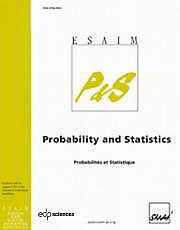Crossref Citations
This article has been cited by the following publications. This list is generated based on data provided by
Crossref.
Arnesen, Petter
Holsclaw, Tracy
and
Smyth, Padhraic
2016.
Bayesian Detection of Changepoints in Finite-State Markov Chains for Multiple Sequences.
Technometrics,
Vol. 58,
Issue. 2,
p.
205.
Brandenburg, Jean-Tristan
Mary-Huard, Tristan
Rigaill, Guillem
Hearne, Sarah J.
Corti, Hélène
Joets, Johann
Vitte, Clémentine
Charcosset, Alain
Nicolas, Stéphane D.
Tenaillon, Maud I.
and
Springer, Nathan M.
2017.
Independent introductions and admixtures have contributed to adaptation of European maize and its American counterparts.
PLOS Genetics,
Vol. 13,
Issue. 3,
p.
e1006666.
Cleynen, Alice
and
Lebarbier, Emilie
2017.
Model selection for the segmentation of multiparameter exponential family distributions.
Electronic Journal of Statistics,
Vol. 11,
Issue. 1,
Celisse, A.
Marot, G.
Pierre-Jean, M.
and
Rigaill, G.J.
2018.
New efficient algorithms for multiple change-point detection with reproducing kernels.
Computational Statistics & Data Analysis,
Vol. 128,
Issue. ,
p.
200.
Zhang, Huiming
and
Wu, Xiaoxu
2019.
Compound Poisson point processes, concentration and oracle inequalities.
Journal of Inequalities and Applications,
Vol. 2019,
Issue. 1,
Diop, Mamadou Lamine
and
Kengne, William
2021.
Piecewise autoregression for general integer-valued time series.
Journal of Statistical Planning and Inference,
Vol. 211,
Issue. ,
p.
271.
Lamine Diop, Mamadou
and
Kengne, William
2021.
Consistent model selection procedure for general integer-valued time series.
Statistics,
Vol. 55,
Issue. 6,
p.
1207.
Liehrmann, Arnaud
Rigaill, Guillem
and
Hocking, Toby Dylan
2021.
Increased peak detection accuracy in over-dispersed ChIP-seq data with supervised segmentation models.
BMC Bioinformatics,
Vol. 22,
Issue. 1,




